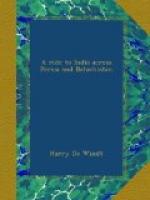The moon had risen by nine o’clock. Before half-past we were in sight of the rock on which stands the town of Yezdi-Ghazt, towering, shadowy and indistinct, over the moonlit plain. This is unquestionably the most curious and interesting village between Resht and Bushire. The post-house stands at the foot. As we rode to the latter through the semi-darkness caused by the shadow of the huge mass of boulders and mud on which the town is situated, the effect was extraordinary. It was like a picture by Gustave Dore; and, looking up the dark perpendicular side of the rock at the weird city with its white houses, queer-shaped balconies, and striped awnings, standing out clear and distinct against the starlit sky, gave one an uncomfortable, uncanny feeling, hard to shake off, and heightened by the fact that, although the hour was yet early, not a light was visible, not a sound to be heard. It was like a city of the dead.
[Illustration: YEZDI-GHAZT]
Daylight does not improve the appearance of Yezdi-Ghazt. The city, which looks so weird and romantic by moonlight, loses much of its beauty, though not its interest, when seen by the broad light of day. The system of drainage in Yezdi-Ghazt is simple, the sewage being thrown over, to fall, haphazard, on the ground immediately below. I nearly had a practical illustration during my examination, which, however, did not last long, for the side of the rock glistened with the filth of years, and the stench and flies were unbearable.
Early next morning I set out alone to explore the strange place, and with much difficulty and some apprehension—for I did not know how the natives were disposed—ascended a steep rocky path, at the summit of which a wooden drawbridge leads over a deep abyss to the gate of the city. This bridge is the only access to Yezdi-Ghazt, which is, so to speak, a regular fortress-town.
The rock, about half a mile long, is intersected by one narrow street, which, covered from end to end with awnings and wooden beams, was almost in obscurity. The sudden change from the glare outside almost blinded one. The appearance of a Farangi is evidently rare in Yezdi-Ghazt, for I was immediately surrounded by a crowd, who, however, were evidently inclined to be friendly, and escorted me to the house of the head-man, under whose guidance I visited the city.
The houses are of stone, two-storied, and mortised into the rock, which gives them the appearance, from below, as if a touch would send them toppling over, while a curious feature is that none of their windows looks inwards to the street—all are in the outside wall facing the desert. I took coffee with the head-man on his balcony—a wooden construction, projecting over a dizzy height, and supported by a couple of rickety-looking beams. It was nervous work, for the flooring, which was rotten and broken into great holes, creaked ominously. I could see Gerome (who had evidently missed me) bustling about the post-house, and reduced, from this height, to the size of a fly. Making this my excuse, I quickly finished my coffee, and bade my host farewell, nor was I sorry to be once more safe on terra firma.




